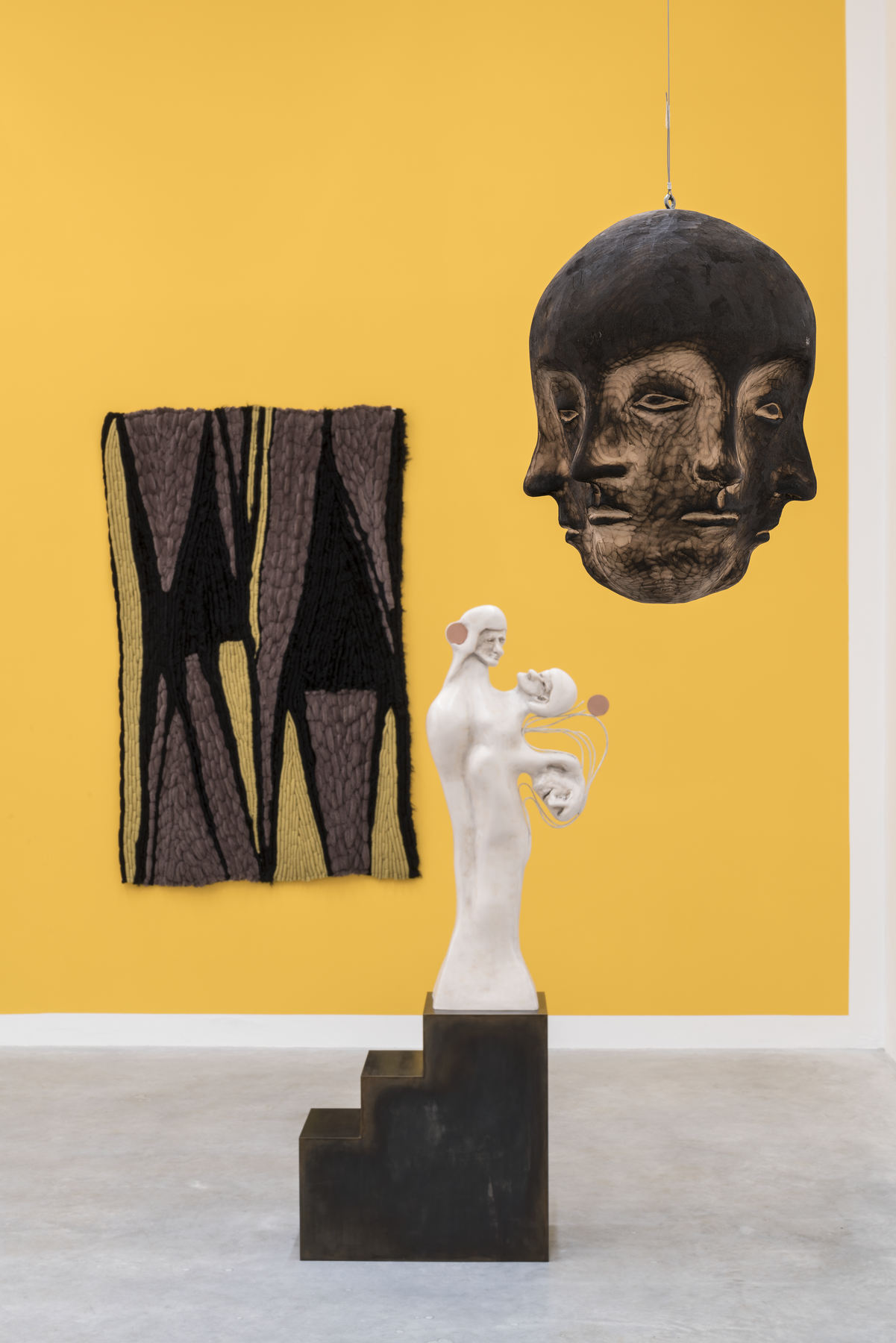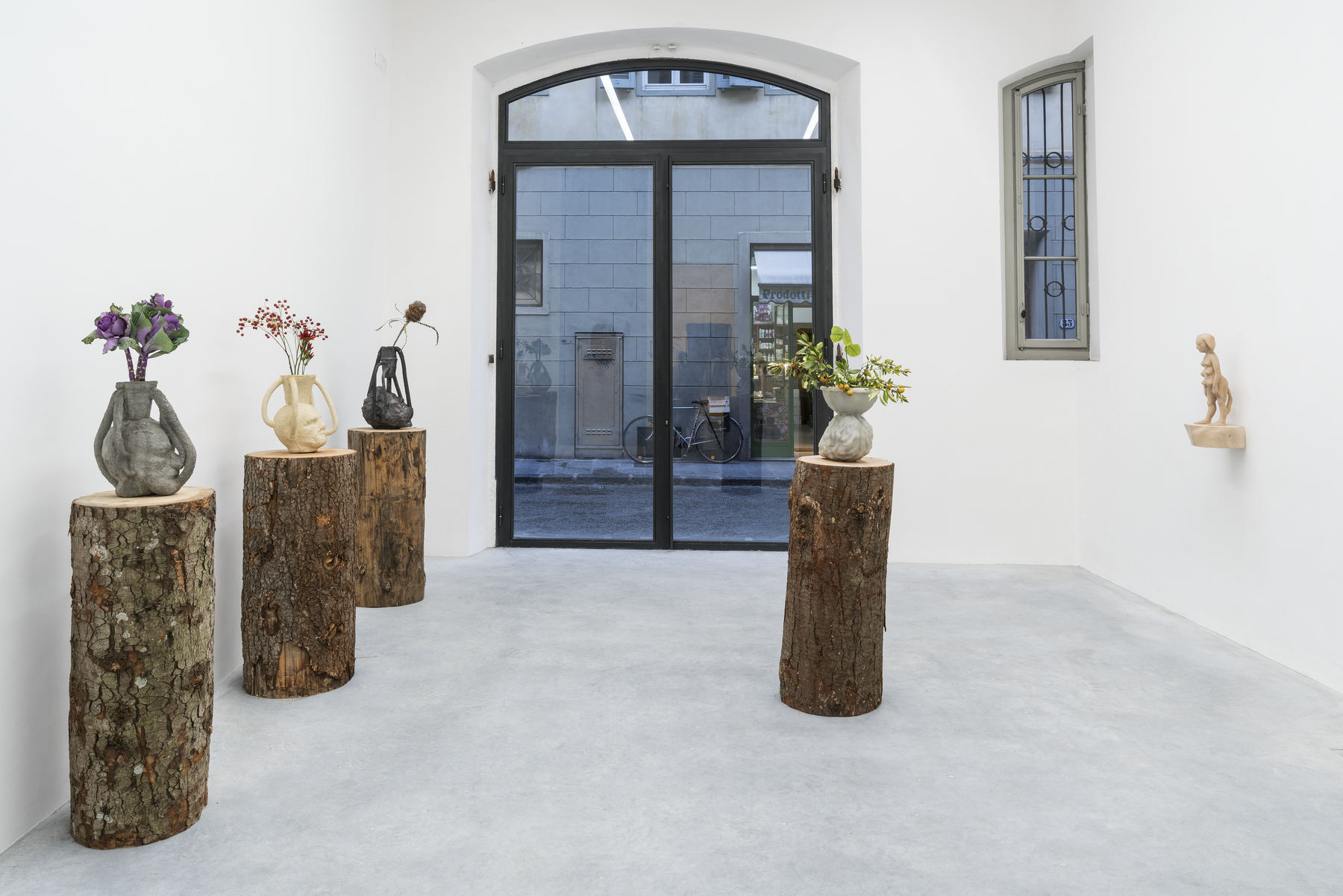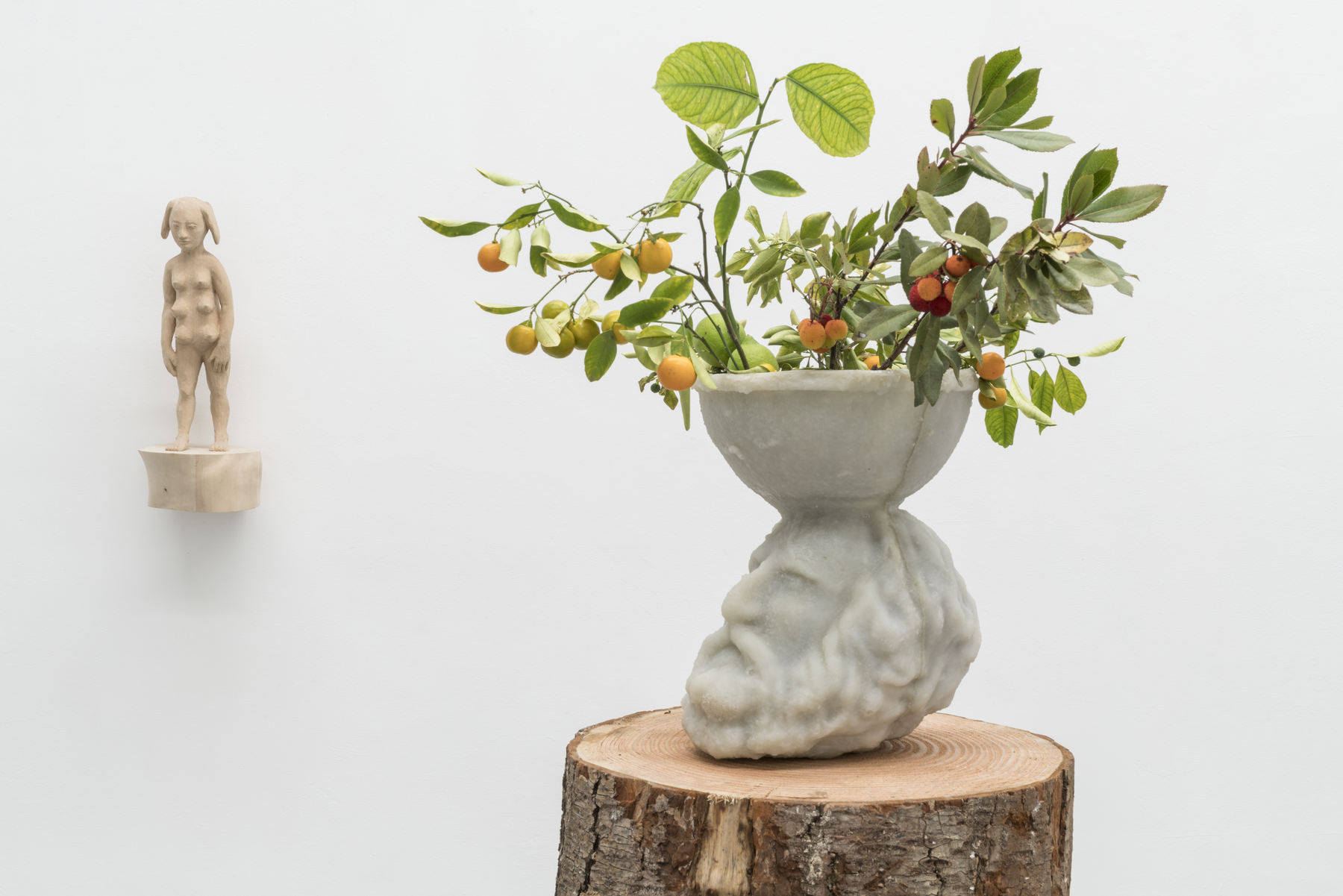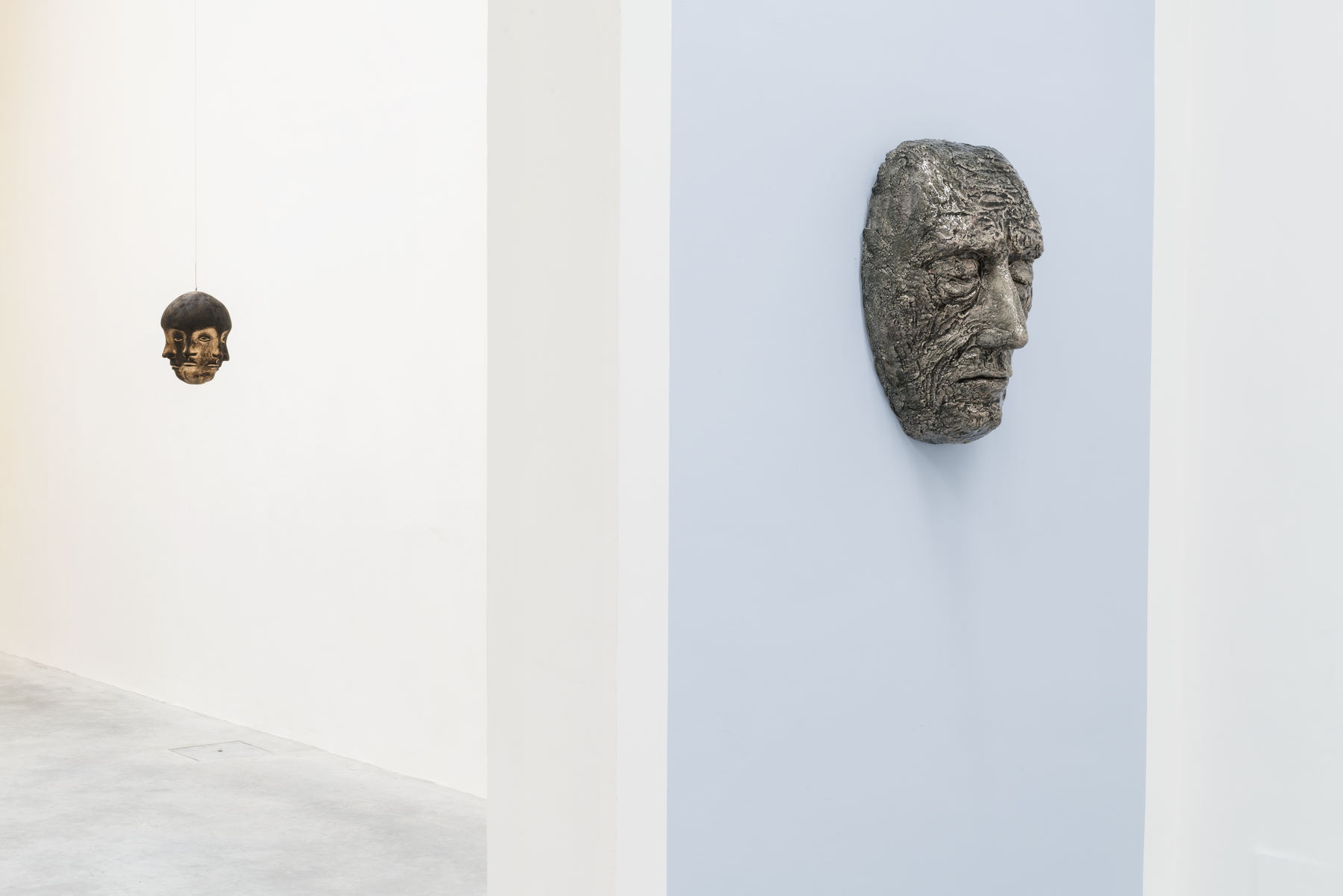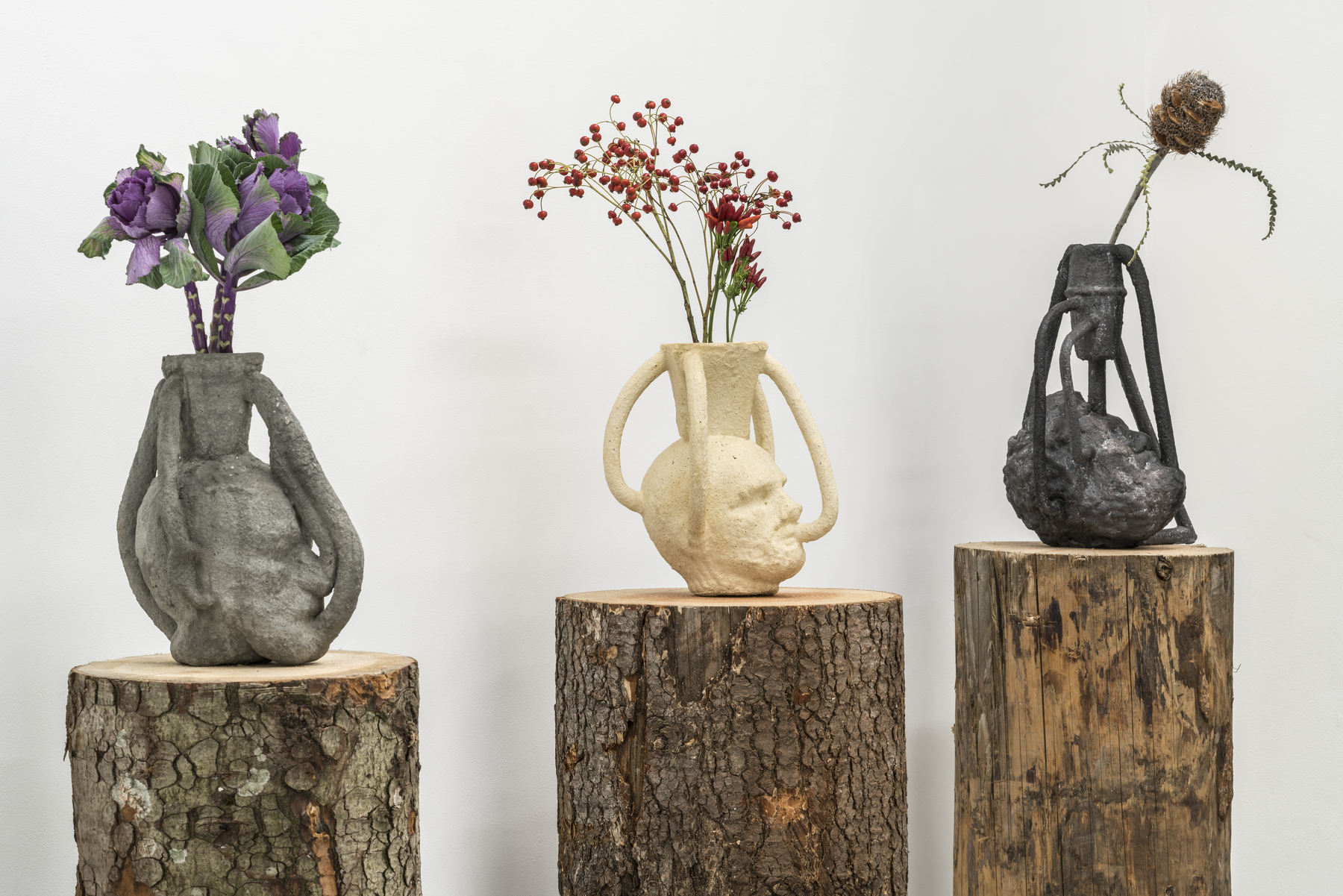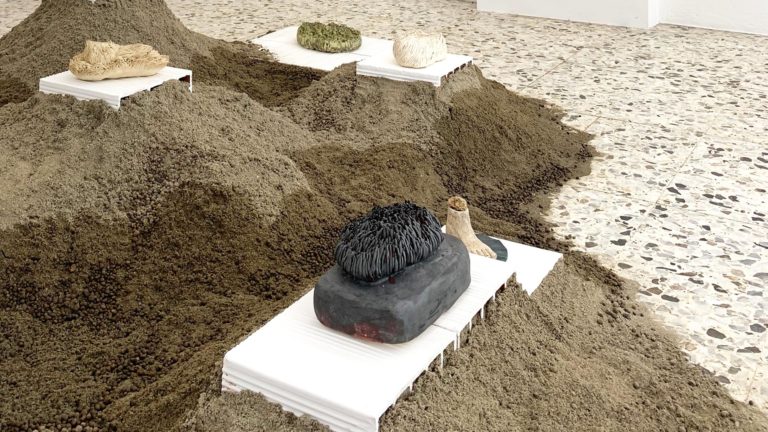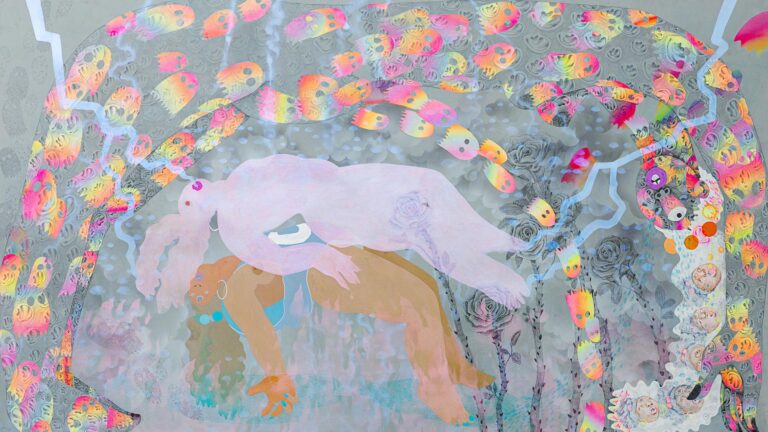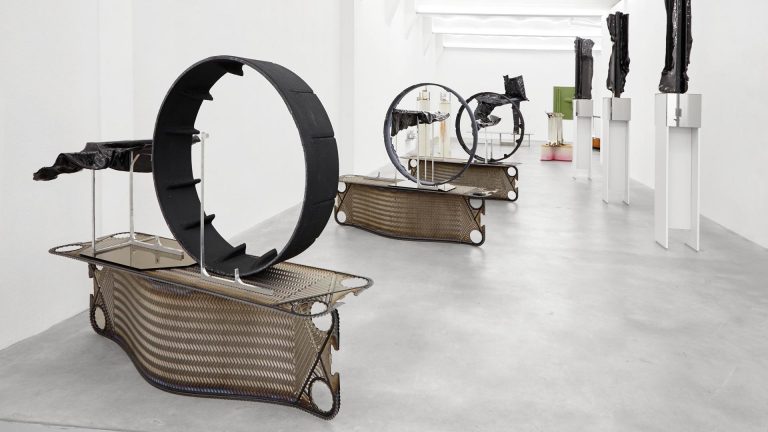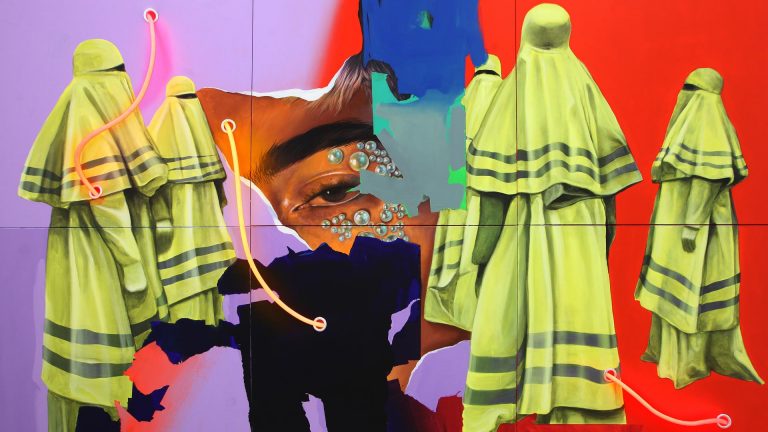Artists: Enrico David, Goshka Macuga, Paloma Varga Weisz
Exhibition title: To the Orthopaedic God
Curated by: Rita Selvaggio
Venue: Galleria Gentili, Florence, Italy
Date: October 27, 2018 – January 6, 2019
Photography: all images copyright and courtesy of the artists and Galleria Gentili, Florence
Al dio ortopedico is a joint exhibition presenting the works of Enrico David (1966), Goshka Macuga (1967) and Paloma Varga Weisz (1966). In a sort of theatrical device and with “an apparent normality of the things represented” as if they were part of everyday reality, the exhibition sets out to explore the question of inner landscape. The title is borrowed from that of an article published in Il Tempo on 22 February 1919 and written by Roberto Longhi (1890-1979), at the time still only nineteen years old, for Giorgio de Chirico’s first solo exhibition in Rome, at Anton Giulio Bragaglia’s Casa d’Arte. “[…] Therein the ‘homo orthopaedicus’ recites his impossible part in the creaking voice of a pulley to the disinherited statues of ancient Greece,” runs the text. It must have been intended as a pitiless mock-ing, and a very modern one for the times, of de Chirico’s use of mannequines, a question that had greatly excited the young scholar’s linguistic imagination. Over the course of history, it has turned out to be one of the most penetrating interpretations of Metaphysical painting.
Giorgio de Chirico had developed a particular conception of the world through his reading of Ni-etzsche, Schopenhauer and Heraclitus and this strong link with philosophy found expression in a manner that was closely bound up with an existential condition. In 1928 Jean Cocteau would de-scribe the artist as a dépaysagiste, not a painter of landscape but someone who disorients.
Florence: de Chirico moved there in 1910, staying for about a year, and the city, with its urban struc-ture exercised a profound influence on his imagination. It was here that he mapped out his themes of mysterious poetic magic: architectural visions, squares of Italy, solitary statues, disquieting man-nequins. And it was in Florence that he painted pictures like The Enigma of an Autumn Afternoon, The Enigma of the Oracle, The Enigma of the Hour and Portrait of the Artist’s Brother, all dating from 1910. As de Chirico himself wrote, his Böcklinian period was over. He had begun to depict subjects in which he sought to express the powerful and mysterious feelings he had discovered in Nietzsche’s books: the melancholy of fine days in autumn, the afternoon in Italian cities. In fact The Enigma of an Autumn Afternoon regarded as his first Metaphysical painting, stems from a vision that he had in Piazza Santa Croce in Florence. It is autumn, a light breeze is blowing and the first yellow leaves are covering the ground, while the artist is seated on a bench gazing at the enormous statue of Dante Alighieri. The long shadows cast by the monument, the mark of an image taken from reality, stir in him the doubt that reality itself is no more than the shadow of something deeper.
The enigma of images, the suspension of time, mystery and disorientation, the appearance of another reality perceived in a world of silence: the exhibition brings together human countenances stripped of identity, mute and inexpressive under windswept and hazy skies. In the exhibition, Goshka Macuga’s assemblage of busts of philosophers and thinkers is emblematic of her imagination of the post-human world. Made of a variety of materials, they are arranged in such a way as to create a silent spatial dialogue, symbolizing the concept of the free exchange of ideas, and belong to the group of works entitled International Institute of Intellectual Co-operation. The works by Enrico David in the show offer further confirmation of his multifarious and decentralized, dissective and dispersive vision, in which everything signifies incessantly and repeatedly. Always at grips with the unobjectifiable, and express-ing an unavoidable impulse that perennially configures spaces of dissent. Paloma Varga Weisz’s Lazlo’s Dream (2018) and Multiface (2018) are part of a recent series of lime-wood sculptures and in addition to alluding to the beginning of the artist’s career, when she was carving wood in Bavaria at the end of the ‘80s, reflect a personal and multi-layered iconography that is surreal, mythological and modernist.
We are in autumn, when the sun starts to remain lower in the sky and shadows lengthen out of all proportion; in the sharp light of the early afternoon, the sense of reality seems to elude the stability and certainties of an objective representation of existence.
To the Orthopaedic God, 2018, exhibition view, Galleria Gentili, Florence
To the Orthopaedic God, 2018, exhibition view, Galleria Gentili, Florence
To the Orthopaedic God, 2018, exhibition view, Galleria Gentili, Florence
To the Orthopaedic God, 2018, exhibition view, Galleria Gentili, Florence
Enrico David, Racket I , 2017, Jesmonite, graphite, wax, copper, patinated steel, 160 x 50 x 30 cm
Enrico David, Untitled, 2014, Bronze, 47,5 x 16 x 15,5 cm
Enrico David, Untitled, 2014, Bronze, 47,5 x 16 x 15,5 cm
Enrico David, Untitled, 2014, Bronze, 47,5 x 16 x 15,5 cm
Enrico David, Racket I , 2017, Jesmonite, graphite, wax, copper, patinated steel, 160 x 50 x 30 cm
Enrico David, Untitled, 2018, Wool on cotton, 178 x 115 cm
Enrico David, Untitled, 2018, Wool on cotton, 178 x 115 cm
Enrico David, Untitled, 2018, Wool on cotton, 178 x 115 cm
To the Orthopaedic God, 2018, exhibition view, Galleria Gentili, Florence
Paloma Varga Weisz, Multiface, 2018, Burned limewood, wire, 30 x 22,5 x 22,5 cm
To the Orthopaedic God, 2018, exhibition view, Galleria Gentili, Florence
To the Orthopaedic God, 2018, exhibition view, Galleria Gentili, Florence
To the Orthopaedic God, 2018, exhibition view, Galleria Gentili, Florence
To the Orthopaedic God, 2018, exhibition view, Galleria Gentili, Florence
To the Orthopaedic God, 2018, exhibition view, Galleria Gentili, Florence
To the Orthopaedic God, 2018, exhibition view, Galleria Gentili, Florence
To the Orthopaedic God, 2018, exhibition view, Galleria Gentili, Florence
To the Orthopaedic God, 2018, exhibition view, Galleria Gentili, Florence
To the Orthopaedic God, 2018, exhibition view, Galleria Gentili, Florence
To the Orthopaedic God, 2018, exhibition view, Galleria Gentili, Florence
To the Orthopaedic God, 2018, exhibition view, Galleria Gentili, Florence
To the Orthopaedic God, 2018, exhibition view, Galleria Gentili, Florence
To the Orthopaedic God, 2018, exhibition view, Galleria Gentili, Florence
To the Orthopaedic God, 2018, exhibition view, Galleria Gentili, Florence
Paloma Varga Weisz, Father, old, 2011, Glazed ceramic, 66 x 42 x 25 cm
Paloma Varga Weisz, Lazlo’s Dream, 2018, Limewood, Figure: 49,5 x 14,5 x 16,5 cm, Overall: 62,5 x 23 x 27 cm
Paloma Varga Weisz, Krummer Hund, 2013, Limewood, wicker, wood, fabric, 201,5 x 118 x 90 cm
Paloma Varga Weisz, Krummer Hund, 2013, Limewood, wicker, wood, fabric, 201,5 x 118 x 90 cm
To the Orthopaedic God, 2018, exhibition view, Galleria Gentili, Florence
To the Orthopaedic God, 2018, exhibition view, Galleria Gentili, Florence
To the Orthopaedic God, 2018, exhibition view, Galleria Gentili, Florence
Goshka Macuga, Ramon Liull, 2016, Rubber and resin, 35 x 28 x 32 cm
Goshka Macuga, Ramon Liull, 2016, Rubber and resin, 35 x 28 x 32 cm
Goshka Macuga, Slavoj Žižek, 2016, Jesmonite and graphite, 55 x 50 x 38 cm
Goshka Macuga, Pussy Riot, 2016, Jesmonite and concrete, 30 x 31 x 37 cm
Goshka Macuga, Sigmund Freud, 2016, Jesmonite and concrete, 39 x 23 x 37 cm

